
Oxygen Saturation (SpO2) Measurement Solutions
Analog Devices’ oxygen saturation (SpO2) measurement application products are powered by low power, integrated optical sensing, and transmitting technology.
These signal chains have enhanced programmability and best-in-class signal-to-noise ratios to accommodate different body locations, even under a challenging perfusion index. Discrete, high-precision amplifiers and converters are offered for the highest clinical-grade performance use cases. Our products offer improved oxygen saturation measurement performance.
Value and Benefits
Our wide range of discrete and integrated analog front ends (AFE) and power solutions help our customers design the next generation of state-of-the-art wearable oxygen saturation equipment. Our high-performance microprocessors, and solutions for motion control and consumable authentication RF interfaces enhance real-time connectivity and provide safety features to be built into wearables.


Offers best-in-class signal-to-noise ratios


Enables the highest clinical-grade use cases


Allows enhanced programmability
Signal Chains
(2)
Interactive Signal Chains


Developer Tools and Resources
Design Tools


Simulation Models
Training and Support
Trainings and Tutorials

Video
Mar 24, 2025
01:07Analog Devices - Powering the Future


Technical Articles
Oct 30, 2023
Clinical-Grade Vital Signs AFE Makes Disease Detection More Than a Stroke of Good Luck


Technical Articles
Sep 28, 2023

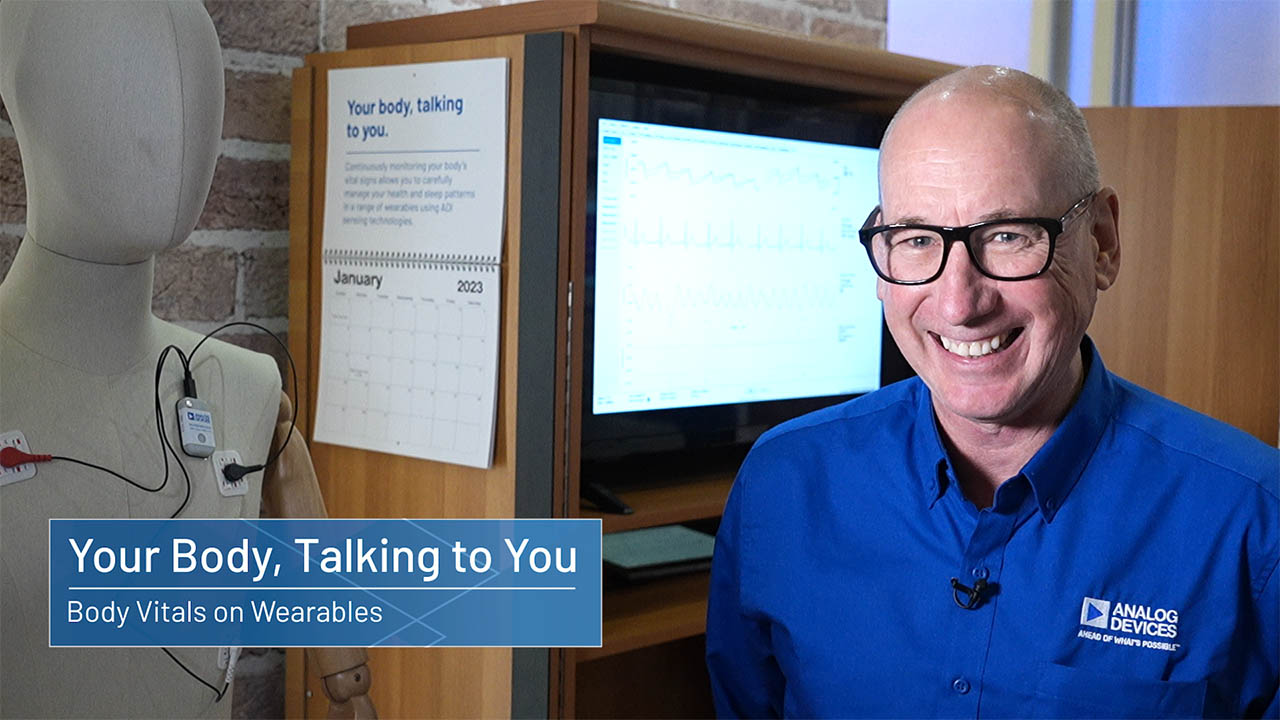
Video
Feb 8, 2023
02:38Body Vitals on Wearables: Your Body, Talking to You


Video
Feb 6, 2023
Leveraging Clinical-Grade Data to Improve Patient Outcomes


Video
Oct 4, 2022
01:45How to Get Your Healthcare Wearable Off the Ground Faster


Video
Sep 21, 2022
Remote Patient Monitoring: Breaking HealthCare’s Boundaries


Video
Jul 18, 2022
03:12Analog Devices Vital Signs Monitoring Solutions


Article
Apr 25, 2022
Vitruvian Shield Vital Signs Monitoring Watch: Peace of Mind for those with Epilepsy


Technical Articles
Feb 22, 2022
Need Clinical-Grade PPG from Your Wearable? Sometimes It Pays NOT to Shine a Light on a Problem


Analog Dialogue
Jan 1, 2022
How to Accelerate Peripheral Monitoring in Low Power Wearables with DMA


Technical Articles
Jun 1, 2021
How to Design a Better Pulse Oximeter


Video
Dec 1, 2020
04:38Vital Signs Monitoring Study Watch


Webcast
Nov 17, 2020
Getting Multiple Vital Signs by a Single Chip for Wearable Devices


Analog Dialogue
Nov 5, 2020
Multiparameter Vital Signs Monitoring Is Easier Than Ever Before

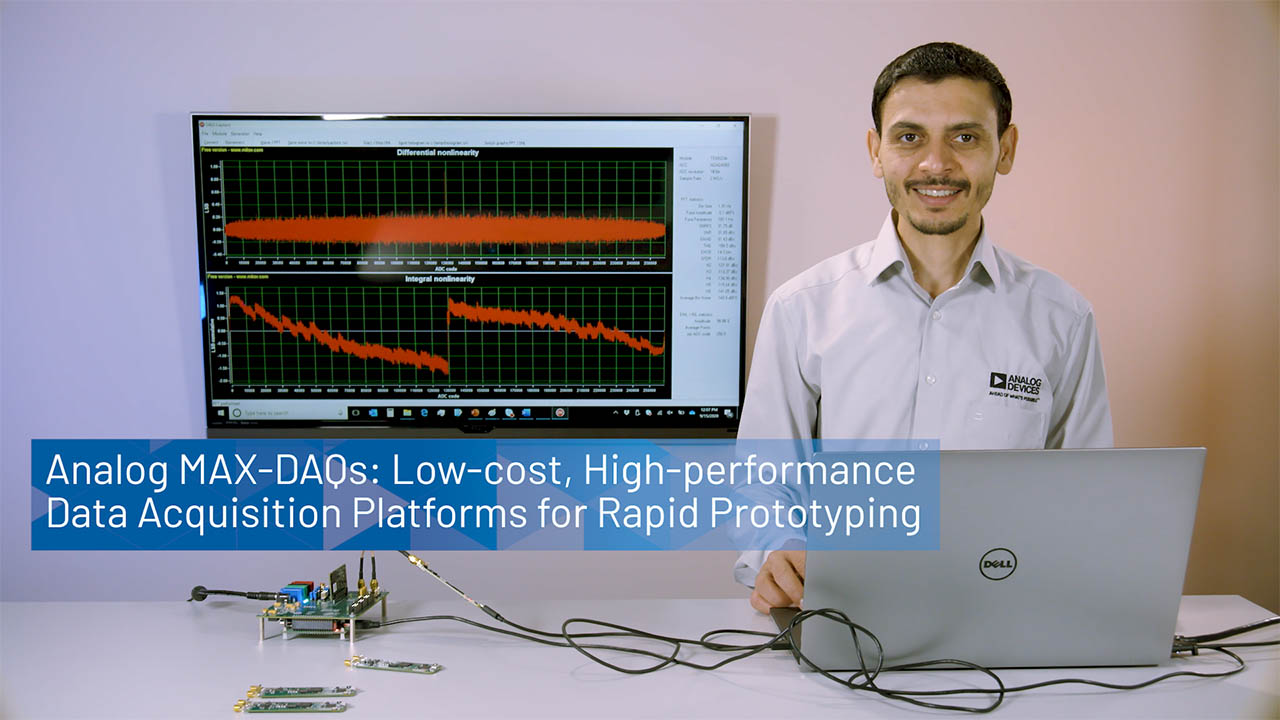
Video
Oct 27, 2020
03:24AnalogMax-DAQ Family Enables Rapid Prototyping


Webcast
Apr 20, 2018
Technologies for Wearable and Clinical Vital Signs Monitoring

Files and Downloads

ADGS1612: SPI Interface, 1 Ω RON, ±5 V, 12 V, 5 V, 3.3 V, Mux Configurable, Quad SPST Switch Data Sheet
373.21 K

Silent Switcher Technology
1.74 M

CN0370: 16-Bit, Single-Supply LED Current Driver with Less than ±1 LSB Integral and Differential Nonlinearity
232.9 K

Understanding Silent Switcher Technology: High Efficiency, Low EMI eBook
7.75 M

Precision Products and Signal Chain Solutions: Selection Guide 2019
13.38 M

The Building Blocks of the IoT
1.83 M

CN0407: Ultrahigh Sensitivity Femtoampere Measurement Platform
548.59 K

ADP5350: Advanced Battery Management PMIC with Inductive Boost LED and Three LDO Regulators Data Sheet
1.68 M

UG-1091: How to Set Up and Use the ADuCM3027/ADuCM3029
1.67 M

Technologies for High Performance Portable Healthcare Devices
598.17 K

ADAS1000 5-Electrode ECG AFE
595.84 K
Show More
ADI Support
Let us know what you need help with, and we will share the best answers from the ADI knowledge database.
Get Help
{{modalTitle}}
{{modalDescription}}
{{dropdownTitle}}
- {{defaultSelectedText}} {{#each projectNames}}
- {{name}} {{/each}} {{#if newProjectText}}
-
{{newProjectText}}
{{/if}}
{{newProjectTitle}}
{{projectNameErrorText}}
Featured Products
MAX86174A
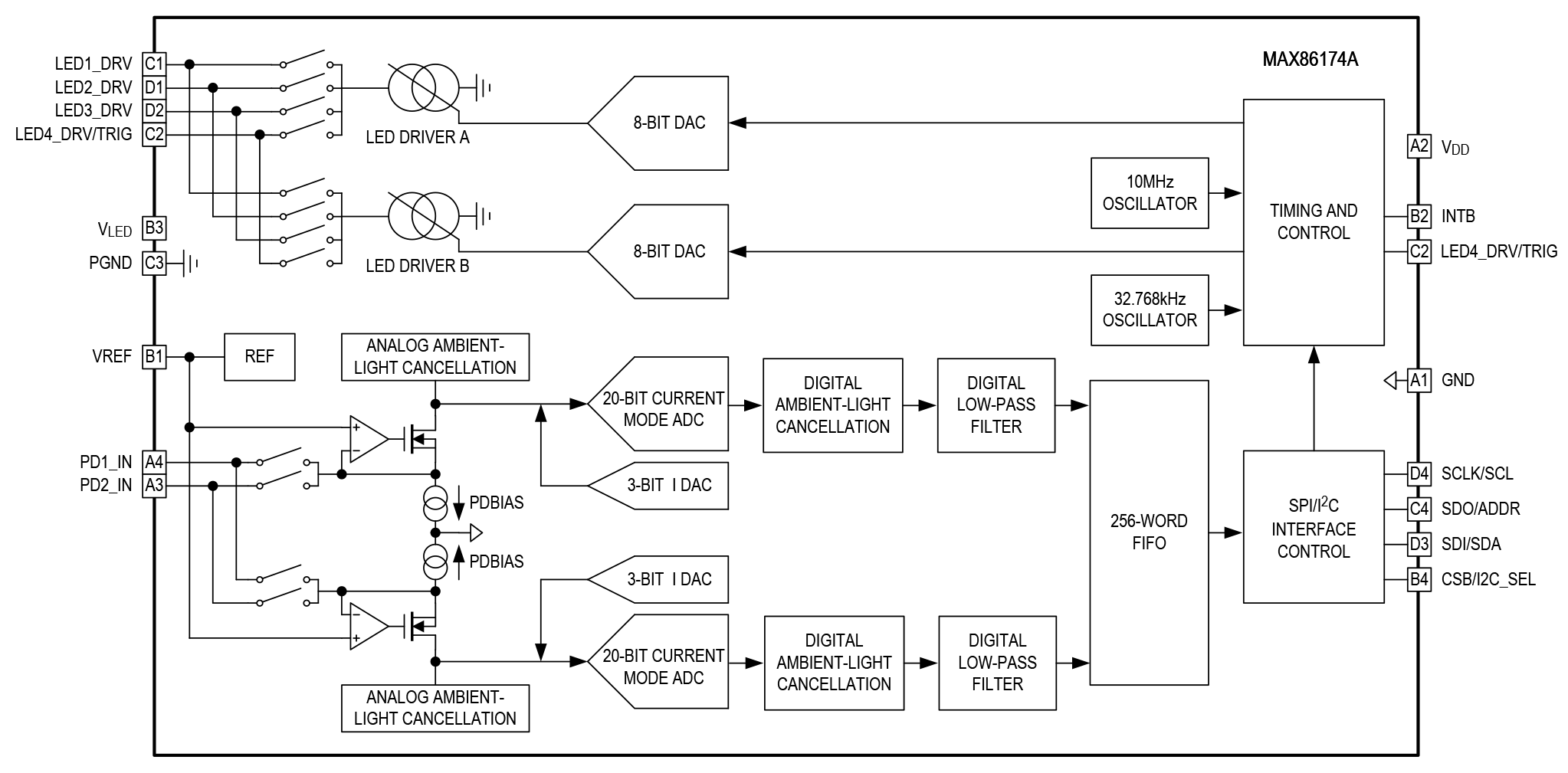
The MAX86174A/MAX86174B are ultra-low-power optical data acquisition systems with both transmit and receive channels. On the transmitter side, the MAX86174A/MAX86174B have four LED driver output pins. Each pin is programmable from two, high-current, 8-bit LED drivers. On the receiver side, the MAX86174A consists of two optical readout channels that can operate simultaneously while the MAX86174B has a single optical readout channel. The devices have low-noise, charge-integrating analog front-end, 20-bit ADC, and best-in-class ambient-light cancellation (ALC) circuits.
Due to the low power consumption, compact size, ease and flexibility of use, the MAX86174A/MAX86174B are ideal for a wide variety of optical sensing applications such as pulse oximetry and heart-rate detection.
The MAX86174A/MAX86174B operate on a 1.8V main supply voltage and a 2.7V to 5.5V LED driver supply voltage. The devices support both I2C- and SPI-compatible interfaces in a fully autonomous way. The devices have a large 256-word built-in FIFO. The MAX86174A/MAX86174B are available in a compact 16-WLP package.
Applications
- Body Hydration
- Clinical Accuracy
- Heart-Rate Variability
- Maximum Oxygen Consumption (VO2 max)
- Muscle and Tissue Oxygen Saturation (SmO2 and StO2)
- Optical Heart Rate
- Optimized Performance to Detect
- Oxygen Saturation (SpO2)
- Suitable for Wrist, Finger, Ear, and Other Locations
- Wearable Devices for Fitness, Wellness and Medical Applications
Applications
Consumer Technology Solutions
- Home Theater and Gaming Solutions
Healthcare Solutions
- Continuous Glucose Monitor (CGM) Solutions
- Diabetes Monitoring and Diagnostic Solutions
- Oxygen Saturation (SpO2) Measurement Solutions
MAXM86146
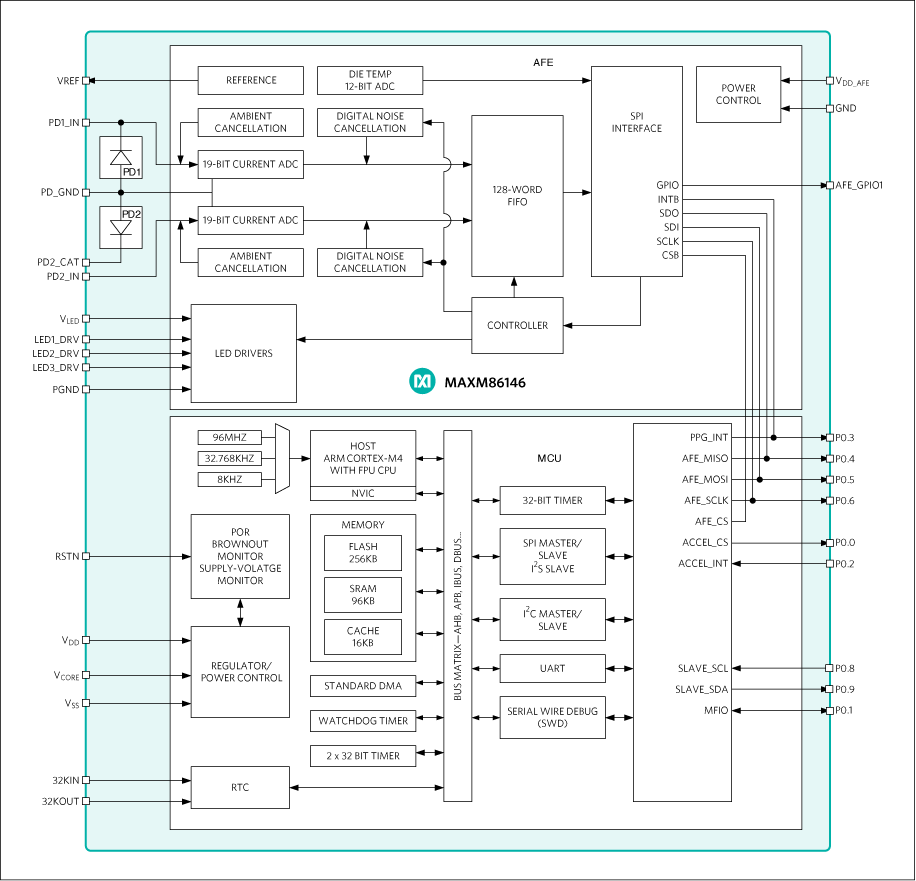
The MAXM86146 is the world’s smallest highly-integrated, optical data acquisition system. It combines Maxim's bestin- class optical biosensing analog front end (AFE) with a powerful Arm® microcontroller unit (MCU) and two high sensitivity photodiodes.
The integrated MCU is an ultra-low-power microcontroller specifically designed for battery-powered devices and wireless sensors. It combines a flexible and versatile power management unit that operates from a single 1.8V supply. It supports I2C communication protocol and is ready to be programmed with the latest firmware and world-class algorithms for wearable applications including pulse heart rate (HR), pulse blood oxygen saturation (SpO2). The integrated algorithms adjust the optical AFE settings to maximize SNR while minimizing power consumption based on activity classification.
The optical AFE has two low-noise optical readout channels. Both channels have independent 19-bit ADCs and an industry-leading ambient light cancellation (ALC) circuit for unparalleled ambient-light rejection in many scenarios. The optical AFE includes three high-current, low-noise LED drivers and operates on a 1.8V main supply voltage and a flexible LED driver supply voltage.
With the addition of external LEDs and an accelerometer (required), a complete system is achieved reducing time to market and simplifying design. This arrangement seamlessly enables customer-desired on-chip processing, resulting in a highly-integrated sensor hub with embedded algorithms.
The MAXM86146 is available in a compact 4.5mm x 4.1mm x 0.88mm, 38-pin OLGA package and operates over commercial temperature range of 0°C to +70°C.
Applications
- Wearable Devices for Fitness and Wellness
- Optimized for Wrist, Finger, and Other Locations
- Optimized Performance to Detect: Pulse Heart Rate (HR) and Arterial Oxygen Saturation (SpO2)
Applications
Consumer Technology Solutions
- Hearable and Wearable Solutions
Healthcare Solutions
- Oxygen Saturation (SpO2) Measurement Solutions
ADPD4100
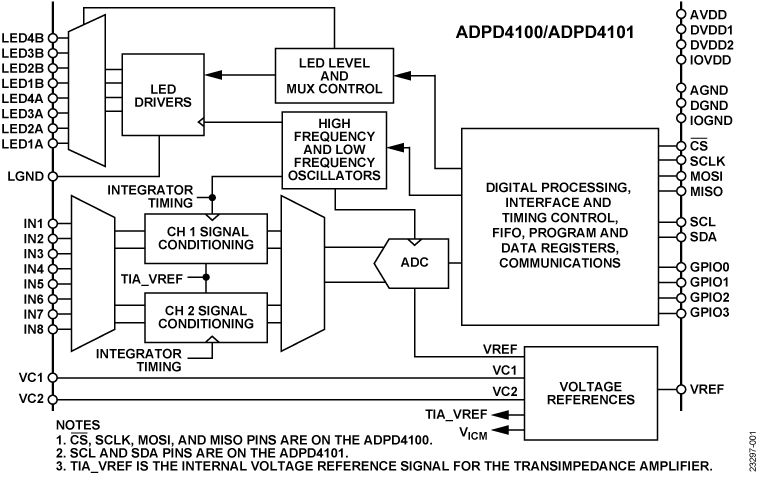
The ADPD4100/ADPD4101 operate as a complete multimodal sensor front end, stimulating up to eight light emitting diodes (LEDs) and measuring the return signal on up to eight separate current inputs. Twelve time slots are available, enabling 12 separate measurements per sampling period.
The data output and functional configuration utilize an I2C interface on the ADPD4101 or a serial port interface (SPI) on the ADPD4100. The control circuitry includes flexible LED signaling and synchronous detection. The devices use a 1.8 V analog core and 1.8 V/3.3 V compatible digital input/output (I/O).
The analog front end (AFE) rejects signal offsets and corruption from asynchronous modulated interference, typically from ambient light, eliminating the need for optical filters or externally controlled dc cancellation circuitry. Multiple operating modes are provided, enabling the ADPD4100/ADPD4101 to be a sensor hub for synchronous measurements of photodiodes, biopotential electrodes, resistance, capacitance, and temperature sensors. The multiple operation modes accommodate various sensor measurements, including, but not limited to, photoplethysmography (PPG), electrocardiography (ECG), electrodermal activity (EDA), impedance, capacitance, temperature, gas detection, smoke detection, and aerosol detection for various healthcare, industrial, and consumer applications.
The ADPD4100/ADPD4101 are available in a 3.11 mm × 2.14 mm, 0.4 mm pitch, 33-ball WLCSP and 35-ball WLCSP
Applications
- Wearable health and fitness monitors: heart rate monitors (HRMs), heart rate variability (HRV), stress, blood pressure estimation, SpO2, hydration, body composition
- Industrial monitoring: CO, CO2, smoke, and aerosol detection
- Home patient monitoring
Applications
Healthcare Solutions
- Activity Tracking and Fall Detection Solutions
- Respiration Rate Measurement Solutions
- Electrocardiogram (ECG) Measurement Solutions
- Wearable Health Monitor Solutions
- Oxygen Saturation (SpO2) Measurement Solutions
- Point of Care (PoC) Diagnostic Solutions
- Non-Invasive Blood Pressure (NIBP) Solutions
Consumer Technology Solutions
- Hearable and Wearable Solutions
ADPD4101

The ADPD4100/ADPD4101 operate as a complete multimodal sensor front end, stimulating up to eight light emitting diodes (LEDs) and measuring the return signal on up to eight separate current inputs. Twelve time slots are available, enabling 12 separate measurements per sampling period.
The data output and functional configuration utilize an I2C interface on the ADPD4101 or a serial port interface (SPI) on the ADPD4100. The control circuitry includes flexible LED signaling and synchronous detection. The devices use a 1.8 V analog core and 1.8 V/3.3 V compatible digital input/output (I/O).
The analog front end (AFE) rejects signal offsets and corruption from asynchronous modulated interference, typically from ambient light, eliminating the need for optical filters or externally controlled dc cancellation circuitry. Multiple operating modes are provided, enabling the ADPD4100/ADPD4101 to be a sensor hub for synchronous measurements of photodiodes, biopotential electrodes, resistance, capacitance, and temperature sensors. The multiple operation modes accommodate various sensor measurements, including, but not limited to, photoplethysmography (PPG), electrocardiography (ECG), electrodermal activity (EDA), impedance, capacitance, temperature, gas detection, smoke detection, and aerosol detection for various healthcare, industrial, and consumer applications.
The ADPD4100/ADPD4101 are available in a 3.11 mm × 2.14 mm, 0.4 mm pitch, 33-ball WLCSP and 35-ball WLCSP
Applications
- Wearable health and fitness monitors: heart rate monitors (HRMs), heart rate variability (HRV), stress, blood pressure estimation, SpO2, hydration, body composition
- Industrial monitoring: CO, CO2, smoke, and aerosol detection
- Home patient monitoring
Applications
Healthcare Solutions
- Point of Care (PoC) Diagnostic Solutions
- Non-Invasive Blood Pressure (NIBP) Solutions
- Wearable Health Monitor Solutions
- Oxygen Saturation (SpO2) Measurement Solutions
- Electrocardiogram (ECG) Measurement Solutions
Instrumentation and Measurement Solutions
- Water and Air Quality Monitoring Solutions
MAX86173

The MAX86173 is an ultra-low-power optical data acquisition system with both transmit and receive channels. On the transmitter side, the MAX86173 has nine LED driver output pins, programmable from three high-current, 8-bit LED drivers. On the receiver side, the MAX86173 has two low-noise charge integrating front-ends that each includes independent 20-bit ADC and best-in-class ambient light cancellation (ALC) circuits, producing the highest performing integrated optical data acquisition system in the market today.
Due to its low power consumption, compact size, ease and flexibility of use, the MAX86173 is ideal for a wide variety of optical sensing applications such as pulse-oximetry and heart-rate detection.
The MAX86173 operates on a 1.8V main supply voltage and a 3.1V to 5.5V LED driver supply voltage. The device supports both I2C and SPI interfaces in a fully autonomous way. The device has a large 256-word built-in FIFO.
The MAX86173 is available in a compact WLP package 2.78mm x 1.71mm with 7 x 4, 0.35mm ball pitch.
Applications
- Wearable Devices for Fitness, Wellness and Medical Applications
- Clinical Accuracy
- Suitable for Wrist, Finger, Ear and Other Locations
- Optimized Performance to Detect:
- Optical Heart Rate
- Heart-Rate Variability
- Oxygen Saturation (SpO2)
- Body Hydration
- Muscle and Tissue Oxygen Saturation (SmO2 and StO2)
- Maximum Oxygen Consumption (VO2 max)
Applications
Healthcare Solutions
- Activity Tracking and Fall Detection Solutions
- Respiration Rate Measurement Solutions
- Electrocardiogram (ECG) Measurement Solutions
- Wearable Health Monitor Solutions
- Oxygen Saturation (SpO2) Measurement Solutions
MAX86177

The MAX86177 is an ultra-low-power optical data acquisition system with both transmit and receive channels. On the transmitter side, it has two, high-current 8-bit programmable LED drivers and supports up to six LEDs. On the receiver side, it has four low-noise charge integrating front-ends that each includes independent 20-bit analog-to-digital converters (ADCs) and best-in-class ambient light cancellation (ALC) circuits, producing the highest performing integrated optical data acquisition system in the market today.
Due to its low power consumption, compact size, ease and flexibility of use, the MAX86177 is ideal for a wide variety of optical sensing applications such as pulse oximetry and heart rate detection.
The MAX86177 operates on a 1.8V main supply voltage and a 3.1V to 5.5V LED driver supply voltage. The device supports both I2C- and SPI-compatible interfaces in a fully autonomous way. The device has a large 512-word built-in FIFO. The MAX86177 is available in a 7 x 4 28-bump wafer level package (WLP) with dimensions of 2.83mm x 1.89mm, and operates over -40ºC to +85ºC temperature range.
Applications
- Clinical Accuracy
- Optimized Performance to Detect: Optical Heart Rate, Heart Rate Variability, Oxygen Saturation (SpO2), Body Hydration, Muscle and Tissue Oxygen Saturation (SmO2 & StO2), Maximum Oxygen Consumption (VO2 Max)
- Suitable for Wrist, Finger, Ear, and Other Locations
- Wearable Devices for Fitness, Wellness, and Medical Applications
Applications
Consumer Technology Solutions
- Hearable and Wearable Solutions
Healthcare Solutions
- Activity Tracking and Fall Detection Solutions
- Respiration Rate Measurement Solutions
- Electrocardiogram (ECG) Measurement Solutions
- Wearable Health Monitor Solutions
- Non-Invasive Blood Pressure (NIBP) Solutions
- Oxygen Saturation (SpO2) Measurement Solutions
MAXM86161
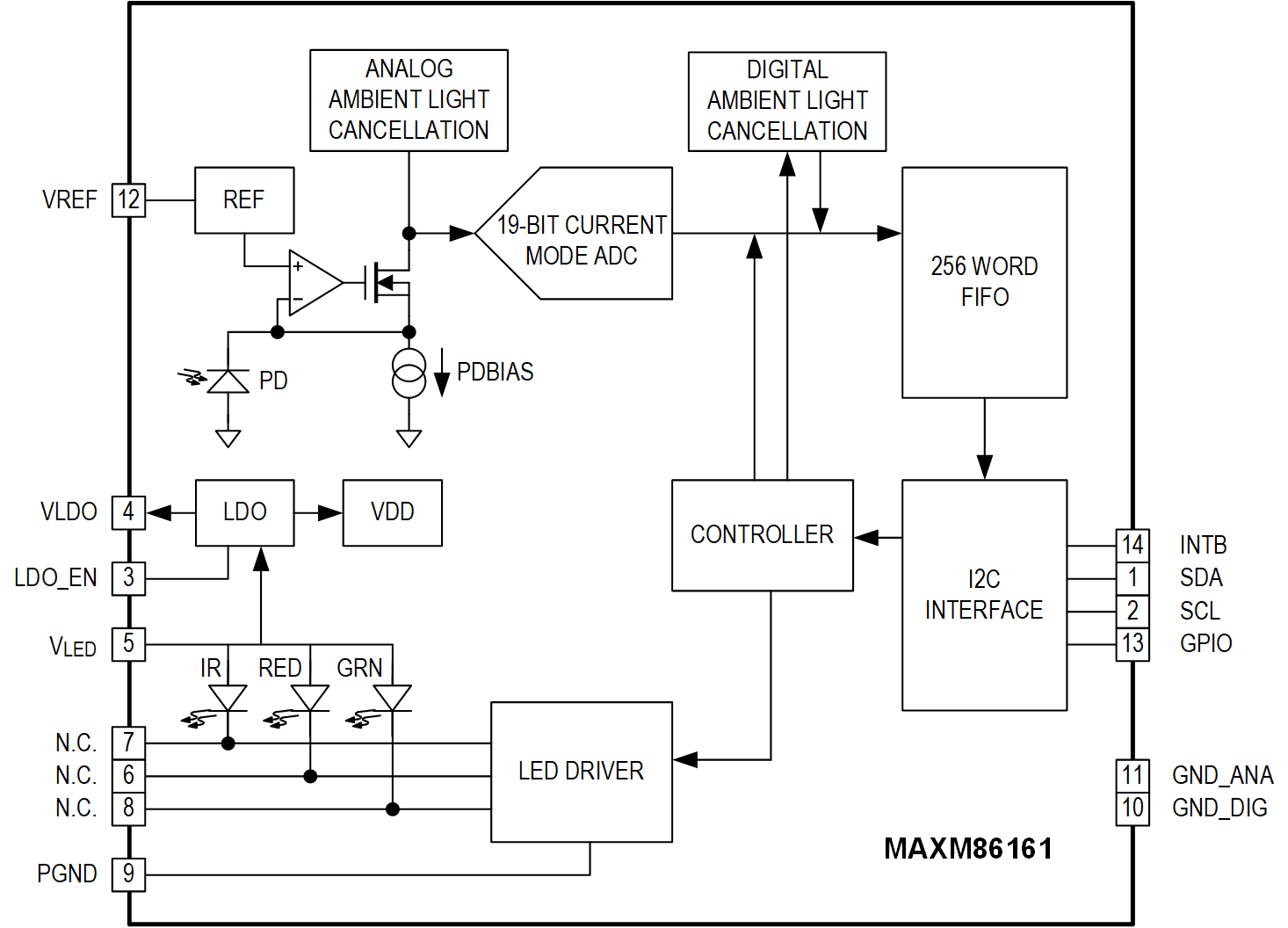
The MAXM86161 is an ultra-low-power, completely integrated, optical data-acquisition system. On the transmitter side, the MAXM86161 has three programmable high-current LED drivers. On the receiver side, MAXM86161 consists of a high efficiency PIN photo-diode and an optical readout channel. The optical readout has a low-noise signal conditioning analog front-end (AFE), including 19-bit ADC, an industry-lead ambient light cancellation (ALC) circuit, and a picket fence detect and replace algorithm. Due to the low power consumption, compact size, easy, flexible-to-use, and industry lead ambient light rejection capability of the MAXM86161, the device is ideal for a wide variety of optical sensing applications such as heart rate detection and pulse oximetry.
The MAXM86161 operates on a 3.0V to 5.5V VLED single supply voltage. It supports a standard compatible interface and fully autonomous operation. Each device has a large 128-word built-in FIFO. The MAXM86161 is available in compact 2.9mm x 4.3mm x 1.4mm, 14-pin OLGA package.
Applications
- Optimized for In-Ear Applications
- Miniature Package for Mobile Applications
- Optimized Performance to Detect:
- Continuous Monitoring for HRV
- Optical Heart Rate
- Oxygen Saturation (SpO2)
Applications
Consumer Technology Solutions
- Home Theater and Gaming Solutions
- Hearable and Wearable Solutions
- Wearable Vital Signs Monitoring Solutions
Healthcare Solutions
- Non-Invasive Blood Pressure (NIBP) Solutions
- Oxygen Saturation (SpO2) Measurement Solutions
MAX86176

The MAX86176 is a complete photoplethysmogram (PPG) and electrocardiogram (ECG) analog front-end (AFE) solution for wearable applications. The MAX30005 is a complete AFE solution for ECG only. Both AFEs offer high performance for fitness and clinical applications with ultra-low power for long battery life.
Both MAX86176 and MAX30005 feature an ECG channel, EMI filtering, internal-lead biasing, AC and DC lead-off detection, right-leg drive, ultra-low power DC lead-on detection during standby mode, and extensive calibration voltages for built in self-test. In addition, the MAX86176 has a PPG data acquisition system supporting up to 6 LEDs and 4 photodiode inputs, which is fully synchronized with the ECG signal path. The MAX86176/MAX30005 can operate with either internal or external clock. The MAX86176/MAX30005 are designed to meet IEC 60601-2-47 Ambulatory ECG Systems monitoring compliance for even the most challenging dry electrode applications.
The MAX86176/MAX30005 are available in a 6x6 36-bump wafer-level packages (WLP), operating over the -40ºC to +85ºC temperature range.
Applications
- PPG (MAX86176): Wearable Devices for Fitness, Wellness and Medical Applications with Clinical Accuracy
- PPG (MAX86176): Suitable for Wrist, Finger, Ear and Other Locations
- PPG (MAX86176): Optimized Performance to Detect Heart Rate, Oxygen Saturation (SpO2), Muscle and Tissue Oxygen Saturation(SmO2 and StO2), and Body Hydration
- ECG (MAX86176/MAX30005): Single-Lead Event Monitors for Atrial Fibrillation (AFib) and other Arrhythmia Detection
- ECG (MAX86176/MAX30005): Single-Lead Wireless Patches for At-Home/In-Hospital Monitoring
- ECG (MAX86176/MAX30005): Chest-Band Heart-Rate Monitors for Fitness Applications
- ECG (MAX86176/MAX30005): Biometric Authentication and ECG-on-Demand Applications
- PPG-ECG SYNC (MAX86176): Fully Synchronized PPG and ECG Signal Path for PTT Measurements
Applications
Consumer Technology Solutions
- Hearable and Wearable Solutions
Healthcare Solutions
- Activity Tracking and Fall Detection Solutions
- Respiration Rate Measurement Solutions
- Electrocardiogram (ECG) Measurement Solutions
- Wearable Health Monitor Solutions
- Continuous Glucose Monitor (CGM) Solutions
- Diabetes Monitoring and Diagnostic Solutions
- Non-Invasive Blood Pressure (NIBP) Solutions
- Oxygen Saturation (SpO2) Measurement Solutions
MAX86178

The MAX86178 is a highly integrated, multiple vital-sign monitoring device with a complete photoplethysmogram (PPG), electrocardiogram (ECG) and biopotential (BioZ) analog front end (AFE) for wearable applications. The MAX86178 offers high performance for wellness and clinical applications with low power for long battery life.
The PPG data acquisition system supports up to 6 LEDs and 4 photodiode inputs. The LEDs are programmable from two high-current, 8-bit LED drivers. The receive path has two low-noise, high-resolution readout channels that each include independent 20-bit ADCs and industry-leading ambient light cancellation (ALC) circuits, producing the highest performing integrated optical data acquisition system on the market today.
The ECG channel has EMI filtering, internal lead biasing, right-leg drive, and extensive calibration voltages for built-in self-test. The ECG channel also has high-input impedance, low noise, high CMRR, programmable gain, an anti-aliasing low-pass filter, and a high-resolution ADC. It is designed to meet IEC 60601-2-47 Ambulatory ECG Systems monitoring compliance requirements.
The BioZ receive channel has EMI filtering and extensive calibration features. The BioZ receive channel also has high input impedance, low noise, programmable gain, low-pass and high-pass filter options, and a high-resolution ADC. There are several modes for generating input stimulus: balanced square-wave source/sink current, sine-wave current, and both sine-wave and square-wave voltage stimuli. A wide range of stimulus magnitudes and frequencies is available.
The MAX86178 has DC and AC lead-off detection, a flexible timing system, and a PLL. All three sensor channels are synchronized. The MAX86178 is available in a 7 x 7 49-bump wafer-level package (WLP) with package dimensions of 2.77mm x 2.57mm, and operates over -40°C to +85°C temperature range.
Applications
- Ambulatory Heart Monitors
- Impedance Cardiography/Hemodynamic Monitors
- Pulse Arrival Time (PAT), Pulse Travel Time (PTT), Pulse Wave Velocity (PWV) Assessments
- Pulse-Oximetry Devices
- Single- and Multi-Frequency Bioimpedance Analysis
- Smart-Clothing Applications
- Wearable Vital-Sign Monitors
Applications
Healthcare Solutions
- Activity Tracking and Fall Detection Solutions
- Respiration Rate Measurement Solutions
- Electrocardiogram (ECG) Measurement Solutions
- Wearable Health Monitor Solutions
- Continuous Glucose Monitor (CGM) Solutions
- Diabetes Monitoring and Diagnostic Solutions
- Body Composition, Hydration, and Bioimpedance Analysis Solutions
- Non-Invasive Blood Pressure (NIBP) Solutions
- Oxygen Saturation (SpO2) Measurement Solutions
Consumer Technology Solutions
- Wearable Vital Signs Monitoring Solutions
- Extended Reality (XR) Solution for Edge Devices
ADPD6000
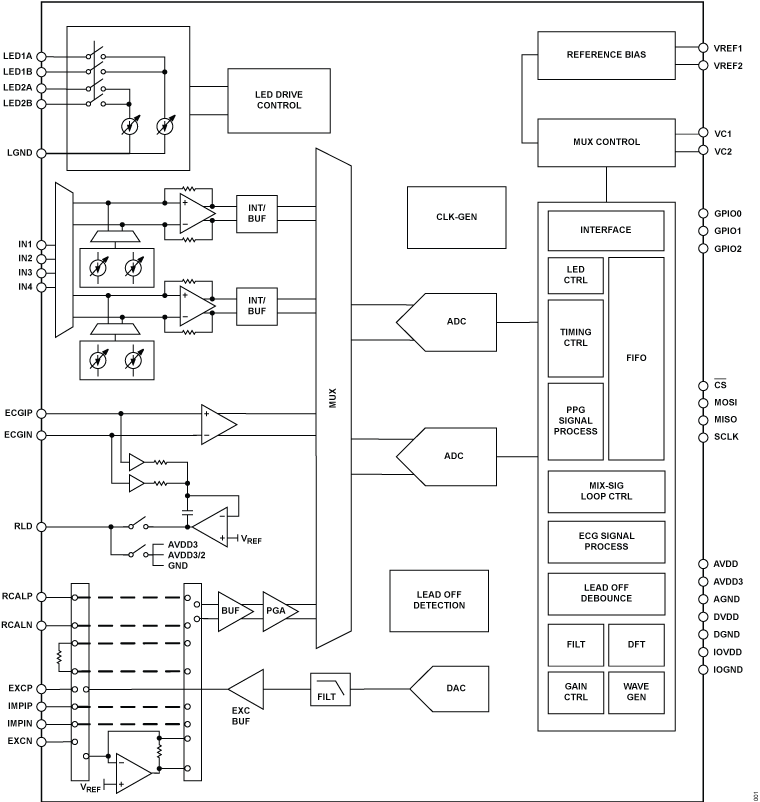
The ADPD6000 is a highly integrated analog front end (AFE) designed for measuring various vital signals.
The optical channel is designed as an optical transceiver, stimulating up to four light emitting diodes (LEDs) and measuring the return signal on up to four separate current inputs. The signal chain rejects signal offsets and corruption from asynchronous modulated interference, typically from ambient light, eliminating the need for optical filters or externally controlled dc cancellation circuitry.
The electrocardiography (ECG) signal acquisition is designed to support low noise, diagnostic level measurement in the presence of a variety of interferers. The ECG signal chain has a number of complementary features supporting ECG measurement, such as driven reference for common-mode rejection and lead off detection to identify a fallen electrode.
The body impedance analysis (BIA) signal chain is designed for body impedance measurement with a configurable excitation path and measurement path. A 12-bit digital-to-analog (DAC) is used in the excitation path to generate the sinusoid wave and high precision measurement, with configurable filters used to measure the body response of the stimulus.
The data output and functional configuration use a serial port interface (SPI) on the ADPD6000. The control circuitry includes flexible LED signaling and synchronous detection, digital filters, digital wave generators, and configurable filters.
The ADPD6000 is available in a 2.6 mm × 2.6 mm, 0.4 mm pitch, 36-ball wafer level chip scale package (WLCSP).
APPLICATIONS
- Wearable health and fitness monitors: heart rate, heart rate variability, SpO2, body impedance analysis, hydration, cuffless noninvasive blood pressure
- Home patient monitoring
- Industrial monitoring: particle and aerosol, gas, and conductivity detection
Applications
Healthcare Solutions
- Non-Invasive Blood Pressure (NIBP) Solutions
- Wearable Health Monitor Solutions
- Oxygen Saturation (SpO2) Measurement Solutions
- Electrocardiogram (ECG) Measurement Solutions
- Respiration Rate Measurement Solutions
MAX32665
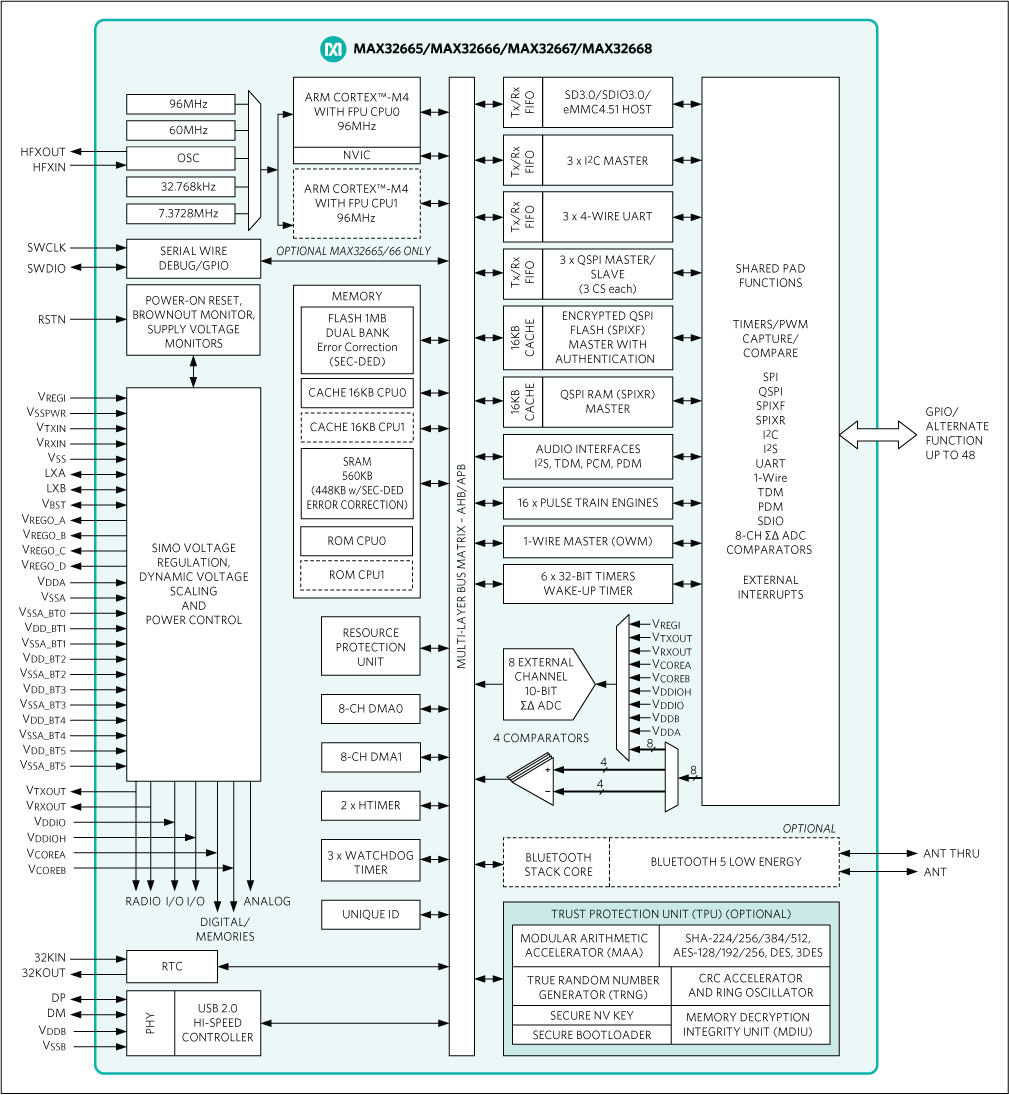
DARWIN is a new breed of low-power microcontrollers built to thrive in the rapidly evolving Internet of Things (IoT). They are smart, with the biggest memories in their class and a massively scalable memory architecture. They run forever, thanks to wearable-grade power technology. They are durable enough to withstand the most advanced cyberattacks. DARWIN microcontrollers are designed to run any application imaginable—in places where you would not dream of sending other microcontrollers.
Generation UB microcontrollers are designed to handle the increasingly complex applications demanded by today's advanced battery-powered devices and wirelessly connected devices, while providing robust hardware security and Bluetooth® 5 Low Energy (Bluetooth LE) radio connectivity.
The MAX32665/MAX32666 UB class microcontrollers are advanced systems-on-chips featuring an Arm® Cortex®-M4 with FPU CPU for efficient computation of complex functions and algorithms with integrated power management. They also include the newest generation Bluetooth 5 LE radio with high throughput (2Mbps) and ADI's best-in-class hardware security suite trust protection unit (TPU). The devices offer large on-board memory with 1MB flash and 560KB SPAM. Split flash banks of 512KB each support seamless over-the-air upgrades, adding an additional degree of reliability. Memory scalability of data (SRAM) and code (flash) space is supported by two SPI execute-in-place (SPIX) interfaces.
Multiple high-speed interfaces are supported including HS-USB, secure digital interface (SD, SDIO, MMC, SDHC, and microSD™), SPI, UART, and I2C serial interfaces, and an audio subsystem supporting PDM, PCM, I2S, and TDM interfaces. An 8-input, 10-bit ADC is available to monitor analog inputs from external sensors and meters. The devices are available in 109-bump WLP (0.35mm pitch) and 121-bump CTBGA (0.65mm pitch).
Applications
- Connected Home
- Gaming Devices
- Hearables
- Industrial Sensors
- Payment/Fitness/Medical Wearables
- Telemedicine
Applications
Consumer Technology Solutions
- Personal Electronics Solutions
- Low Power and High Security Solutions for Personal Electronics
MAX32670
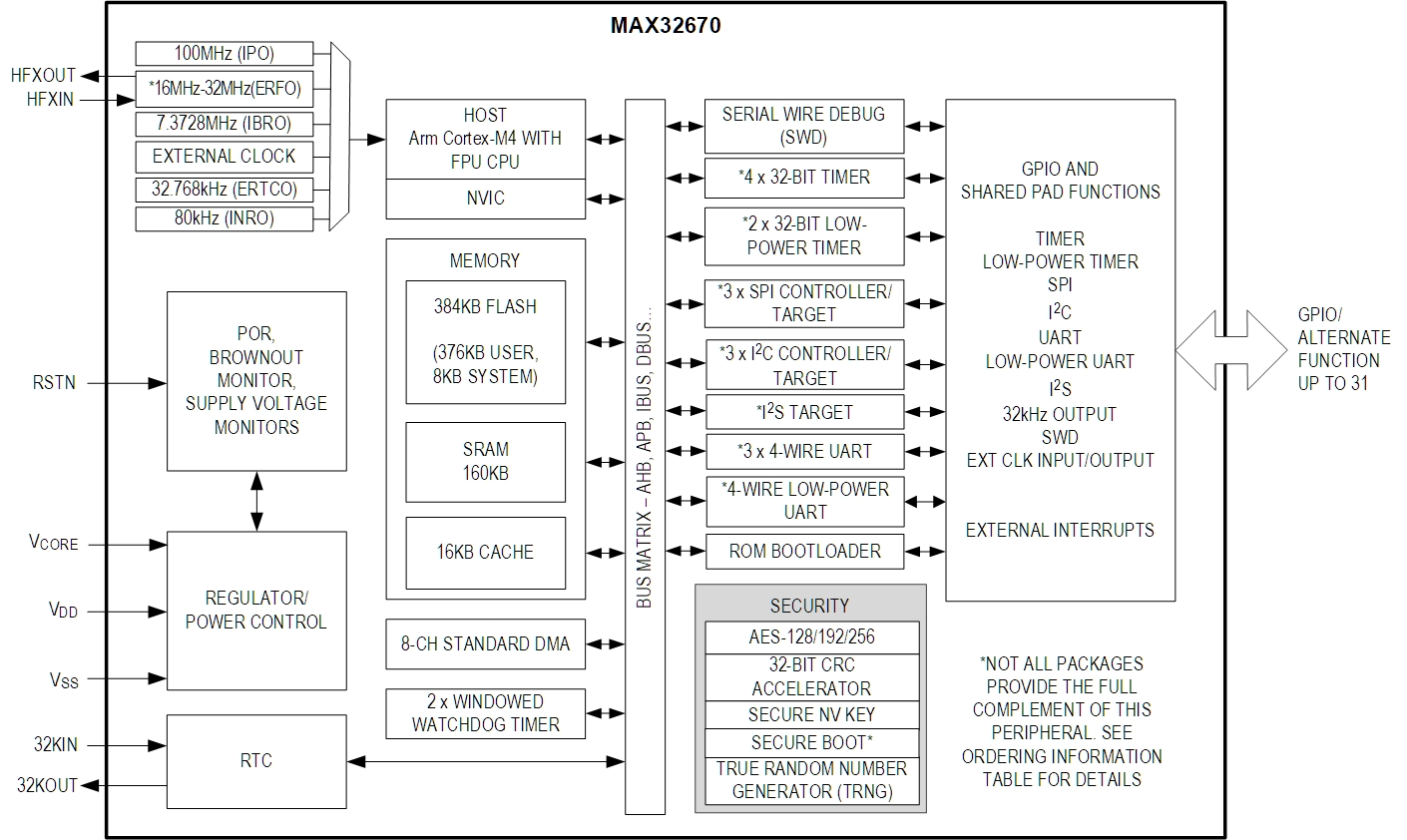
In the Darwin family, the MAX32670 is an ultra-low-power, cost-effective, high-reliability 32-bit microcontroller enabling designs with complex sensor processing without compromising battery life. It combines a flexible and versatile power management unit with the powerful Arm® Cortex®-M4 processor with a floating point unit (FPU). It also offers legacy designs an easy and cost-optimal upgrade path from 8- or 16-bit microcontrollers.
The device integrates 384KB (376KB user) of flash memory and 160KB of SRAM to accommodate application and sensor code. Additional features, such as the two windowed watchdog timers with fully flexible and independent clocking, have been added to further enhance reliable operation. Brown-out detection ensures proper operation during power-down/power-up events and unexpected supply transients.
Multiple high-speed peripherals such as 3.4MHz I2C, 50MHz SPI, and UARTs maximize communication bandwidth. In addition, a low-power UART is available for operation in the lowest-power sleep modes to facilitate wake-up on activity without any loss of data. A total of six timers with I/O capability are provided, including two low-power timers to enable pulse counting, capture/compare, and PWM generation in the lowest-power sleep modes. All of this capability is packaged in a tiny form factor: 5mm × 5mm, 40-pin TQFN-EP or 1.75mm × 2.50mm, 24-bump WLP.
Applications
- Smart Sensor Controller
- Industrial Sensors
- Optical Communication Modules
- Secure Radio Modem Controller
- Battery-Powered Medical Devices
- System Housekeeping Controller
- Algorithm Coprocessor
Applications
Energy Solutions
- Smart Meter Technology
Healthcare Solutions
- Therapy Device Solutions for Healthcare
- Activity Tracking and Fall Detection Solutions
- Respiration Rate Measurement Solutions
- Electrocardiogram (ECG) Measurement Solutions
- Wearable Health Monitor Solutions
- Oxygen Saturation (SpO2) Measurement Solutions
Intelligent Building Solutions
- Smoke Detection Systems
- Surveillance Camera Solutions
- Building Automation Controllers and Network Solutions
Industrial Automation
- Smart Factory IO - Link Sensor Actuator Solutions
- Smart Factory IO - Link Master Solutions
MAX30101

The MAX30101 is an integrated pulse oximetry and heart-rate monitor module. It includes internal LEDs, photodetectors, optical elements, and low-noise electronics with ambient light rejection. The MAX30101 provides a complete system solution to ease the design-in process for mobile and wearable devices.
The MAX30101 operates on a single 1.8V power supply and a separate 5.0V power supply for the internal LEDs. Communication is through a standard I2C-compatible interface. The module can be shut down through software with zero standby current, allowing the power rails to remain powered at all times.
Applications
- Fitness Assistant Devices
- Smartphones
- Tablets
- Wearable Devices
Applications
Consumer Technology Solutions
- Hearable and Wearable Solutions
Healthcare Solutions
- Oxygen Saturation (SpO2) Measurement Solutions
ADPD105
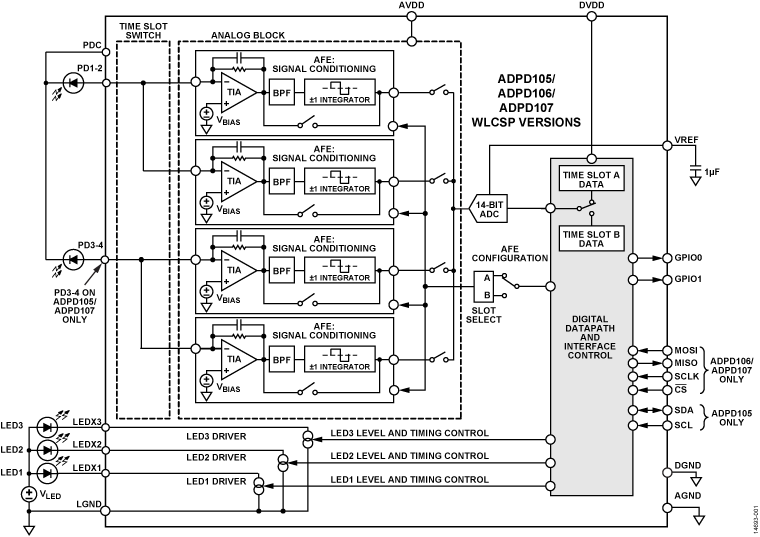
The ADPD105/ADPD106/ADPD107 are highly efficient, photometric front ends, each with an integrated 14-bit analog-to-digital converter (ADC) and a 20-bit burst accumulator that works with flexible light emitting diode (LED) drivers. The accumulator is designed to stimulate an LED and measure the corresponding optical return signal. The data output and functional configuration occur over a 1.8 V I2C interface on the ADPD105 or SPI on the ADPD106 and ADPD107. The control circuitry includes flexible LED signaling and synchronous detection.
The analog front end (AFE) features best-in-class rejection of signal offset and corruption due to modulated interference commonly caused by ambient light.
Couple the ADPD105/ADPD106/ADPD107 with a low capacitance photodiode of <100 pF for optimal performance. The ADPD105/ADPD106/ADPD107 can be used with any LED. The ADPD105 is available in a 2.46 mm × 1.4 mm WLCSP and a 4 mm × 4 mm LFCSP. The SPI only versions, ADPD106 and ADPD107, are available in a 2.46 mm × 1.4 mm WLCSP.
Applications
- Wearable health and fitness monitors
- Clinical measurements, for example, SpO2
- Industrial monitoring
- Background light measurements
Applications
Intelligent Building Solutions
- Smart Building Automation Systems
- Building Lighting Technology Solutions
- Environmental Building Monitoring Solutions
- Building Energy Technology Solutions
- Building Fire Safety and Surveillance Solutions
Healthcare Solutions
- Vital Signs Monitoring Solutions
- Non-Invasive Blood Pressure (NIBP) Solutions
- Oxygen Saturation (SpO2) Measurement Solutions
- Wearable Health Monitor Solutions
ADPD106

The ADPD105/ADPD106/ADPD107 are highly efficient, photometric front ends, each with an integrated 14-bit analogto-digital converter (ADC) and a 20-bit burst accumulator that works with flexible light emitting diode (LED) drivers. The accumulator is designed to stimulate an LED and measure the corresponding optical return signal. The data output and functional configuration occur over a 1.8 V I2C interface on the ADPD105 or SPI on the ADPD106 and ADPD107. The control circuitry includes flexible LED signaling and synchronous detection.
The analog front end (AFE) features best-in-class rejection of signal offset and corruption due to modulated interference commonly caused by ambient light.
Couple the ADPD105/ADPD106/ADPD107 with a low capacitance photodiode of <100 pF for optimal performance. The ADPD105/ADPD106/ADPD107 can be used with any LED. The ADPD105 is available in a 2.46 mm × 1.4 mm WLCSP and a 4 mm × 4 mm LFCSP. The SPI only versions, ADPD106 and ADPD107, are available in a 2.46 mm × 1.4 mm WLCSP.
Applications
- Wearable health and fitness monitors
- Clinical measurements, for example, SpO2
- Industrial monitoring
- Background light measurements
Applications
Healthcare Solutions
- Vital Signs Monitoring Solutions
- Non-Invasive Blood Pressure (NIBP) Solutions
- Oxygen Saturation (SpO2) Measurement Solutions
- Wearable Health Monitor Solutions
ADPD107

The ADPD105/ADPD106/ADPD107 are highly efficient, photometric front ends, each with an integrated 14-bit analog-to-digital converter (ADC) and a 20-bit burst accumulator that works with flexible light emitting diode (LED) drivers. The accumulator is designed to stimulate an LED and measure the corresponding optical return signal. The data output and functional configuration occur over a 1.8 V I2C interface on the ADPD105 or SPI on the ADPD106 and ADPD107. The control circuitry includes flexible LED signaling and synchronous detection.
The analog front end (AFE) features best-in-class rejection of signal offset and corruption due to modulated interference commonly caused by ambient light.
Couple the ADPD105/ADPD106/ADPD107 with a low capacitance photodiode of <100 pF for optimal performance. The ADPD105/ADPD106/ADPD107 can be used with any LED. The ADPD105 is available in a 2.46 mm × 1.4 mm WLCSP and a 4 mm × 4 mm LFCSP. The SPI only versions, ADPD106 and ADPD107, are available in a 2.46 mm × 1.4 mm WLCSP.
Applications
- Wearable health and fitness monitors
- Clinical measurements, for example, SpO2
- Industrial monitoring
- Background light measurements
Applications
Healthcare Solutions
- Vital Signs Monitoring Solutions
- Non-Invasive Blood Pressure (NIBP) Solutions
- Oxygen Saturation (SpO2) Measurement Solutions
- Wearable Health Monitor Solutions
ADPD144RI
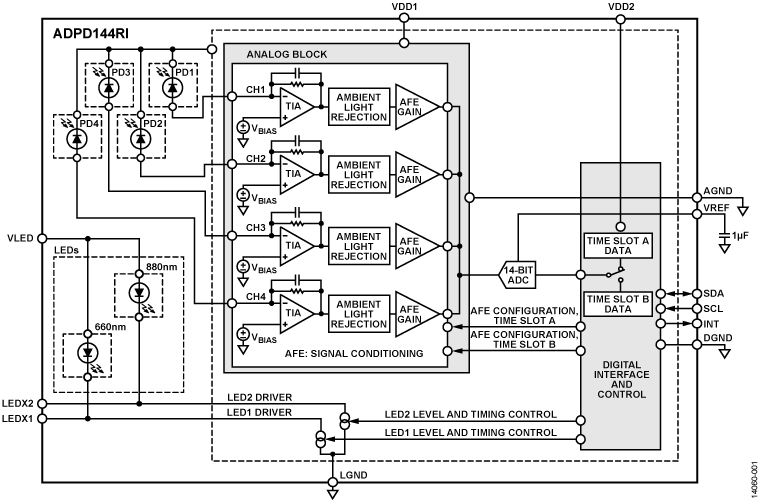
The ADPD144RI is a highly integrated, photometric front end optimized for photoplethysmography (PPG) detection of blood oxygenation (SpO2) by synchronous detection in red and infrared wavelengths. Synchronous measurement allows rejection of both dc and ac ambient light interference with extremely low power consumption.
The module combines highly efficient, light emitting diode (LED) emitters and a sensitive 4-channel, deep diffusion photodiode (PD1 to PD4) with a custom application specific integrated circuit (ASIC) in a compact package that provides optical isolation between the integrated LED emitters and the detection photodiodes to improve through tissue, signal-tonoise ratio (SNR).
The ASIC consists of a 4-channel analog front end (AFE) with two independently configurable datapaths with separate gain and filter settings, a 14-bit analog-to-digital converter (ADC) with a burst accumulator, two flexible, independently configurable, LED drivers, and a digital control block. The digital control block provides AFE and LED timing, signal processing, and communication. Data output and functional configuration occur over a 1.8 V I2C interface.
Applications
- Optical heart rate monitoring
- Reflective SpO2 measurement
Applications
Consumer Technology Solutions
- Hearable and Wearable Solutions
Healthcare Solutions
- Vital Signs Monitoring Solutions
- Non-Invasive Blood Pressure (NIBP) Solutions
- Respiration Rate Measurement Solutions
- Oxygen Saturation (SpO2) Measurement Solutions
- Wearable Health Monitor Solutions
Evaluation Boards
MAXM86146EVSYS
The MAXM86146 evaluation system (EV system) allows for the quick evaluation of the MAXM86146 optical mod- ule for applications at various sites on the body, particu- larly the wrist. MAXM86146 supports UART, I2C, and SPI compatible interfaces. MAXM86146 has two optical read- out channels that operate simultaneously. The EV system allows flexible configurations to optimize measurement signal quality at minimal power consumption. It helps the user quickly learn about how to configure and use the MAXM86146.
The EV system consists of two boards. MAXSensor BLE# is the main data acquisition board while MAXM86146_ OSB# is the sensor daughter board for MAXM86146. The EV system can be powered using the USB-C supply or LiPo Battery. The EV system comes with a MAXM86146CFU+.
Applications
- Optical Heart Rate (HR)
- Optimized performance for high SNR PPG signal to detect
- Oxygen Saturation
- Suitable for Wrist, Finger, Ear, Chest, and Abdomen
- Wearable Devices for Fitness, Wellness & Medical Applications
Applicable Parts
MAXM86146
Complete Optical Biosensing Module with Ultra-Low-Power Biometric Sensor Hub
Applications
Consumer Technology Solutions
- Hearable and Wearable Solutions
Healthcare Solutions
- Oxygen Saturation (SpO2) Measurement Solutions
EVAL-ADPD4100Z-PPG

The EVAL-ADPD4100Z-PPG evaluation board provides users with a simple means of evaluating the ADPD4100/ADPD4101 photometric front end.
The EVAL-ADPD4100Z-PPG evaluation board implements a simple discrete optical design for vital signs monitoring applications, specifically wrist-based photoplethysmography (PPG).
The EVAL-ADPD4100Z-PPG has three green light emitting diodes (LEDs), one infrared (IR), and one red LED, all separately driven. A single 7 mm2 photodiode (PD) is populated on the board. The PD has no optical filter coating. However, a pin for pin alternative device with an IR block filter is available.
The full evaluation system includes the Wavetool Evaluation Software graphical user interface (GUI) that provides users with low level register access and high level system configurability. Raw data streamed to this tool can be displayed in real time with limited latency. Views are provided for both frequency and time domain analysis.
A user datagram protocol (UDP) transfer capability from the Wavetool Evaluation Software (available for download on the EVAL-ADPD4100Z-PPG product page) allows data stream connections and register configurability to external analysis programs, such as LabVIEW® or MATLAB®, in real time.
The EVAL-ADPD4100Z-PPG board is powered by the EVAL-ADPDUCZ microcontroller board (obtained from the EVAL-ADPD4100Z-PPG product page). In addition to the power requirements, serial port interface (SPI) (default) or I2 C data streams are received from the ADPD4100 by the microcontroller. A ribbon cable connects the two boards. The microcontroller repackages the data, sending it to a virtual serial port over the USB to the PC, displayed on the Wavetool Evaluation Software. The EVAL-ADPD4100Z-PPG can also be connected directly to the microcontroller development system of the user, using the SPI for the ADPD4100 (or I2C for the ADPD4101).
The ADPD4100/ADPD4101 data sheet, available at www.analog.com, provides full specifications for the ADPD4100/ADPD4101. Consult the ADPD4100/ADPD4101 data sheet in conjunction with this user guide when using the EVAL-ADPD4100Z-PPG.
Applications
Healthcare Solutions
- Activity Tracking and Fall Detection Solutions
- Wearable Health Monitor Solutions
- Point of Care (PoC) Diagnostic Solutions
- Electrocardiogram (ECG) Measurement Solutions
- Oxygen Saturation (SpO2) Measurement Solutions
- Respiration Rate Measurement Solutions
- Vital Signs Monitoring Solutions
- Non-Invasive Blood Pressure (NIBP) Solutions
Instrumentation and Measurement Solutions
- Water and Air Quality Monitoring Solutions
MAX86176EVSYS

The MAX86176 evaluation kit (EV kit) provides a platform to evaluate the functionality and features of the MAX86176 with photoplethysmogram (PPG) and electrocardiogram (ECG) measurement capabilities. The EV kit allows for flexible hardware and software configurations to help the user quickly learn how to configure and optimize the MAX86176 for their own applications.
The MAX86176 is a complete PPG and ECG analog front-end solution that consists of two optical readout channels and one single-lead ECG channel that can operate simultaneously. The optical readout channels support up to 6 LEDs and 4 photodiode inputs.
The MAX86176 EV kit consists of two boards. MAXSENSORBLE_HEADER_EVKIT_A is the microcontroller (MCU) board while MAX86176_EVKIT_A is the sensor board containing the MAX86176. To enable PPG and ECG measurement capabilities, the sensor board also contains 3 LEDs (red, green, and IR), 3 discrete photodiodes (Vishay VEMD8080), a 3 LED, 1 photodiode module (Osram SFH7050), and component configurations on the ECG channel. The EV kit can be powered through USB connection to PC using a USB-C to USB-A cable or a LiPo Battery. The EV kit relays data using Bluetooth through the Cypress USB Bluetooth LE dongle. The EV kit contains with the latest firmware but comes with the programming circuit board MAXREFDES100HDK in case a firmware change is needed.
Applications
- ECG (MAX86176/MAX30005): Biometric Authentication and ECG-on-Demand Applications
- ECG (MAX86176/MAX30005): Chest-Band Heart-Rate Monitors for Fitness Applications
- ECG (MAX86176/MAX30005): Single-Lead Event Monitors for Atrial Fibrillation (AFib) and other Arrhythmia Detection
- ECG (MAX86176/MAX30005): Single-Lead Wireless Patches for At-Home/In-Hospital Monitoring
- PPG (MAX86176): Optimized Performance to Detect Heart Rate, Oxygen Saturation (SpO2), Muscle and Tissue Oxygen Saturation(SmO2 and StO2), and Body Hydration
- PPG (MAX86176): Suitable for Wrist, Finger, Ear and Other Locations
- PPG (MAX86176): Wearable Devices for Fitness, Wellness and Medical Applications with Clinical Accuracy
- PPG-ECG SYNC (MAX86176): Fully Synchronized PPG and ECG Signal Path for PTT Measurements
Applicable Parts
Applications
Consumer Technology Solutions
- Hearable and Wearable Solutions
Healthcare Solutions
- Activity Tracking and Fall Detection Solutions
- Respiration Rate Measurement Solutions
- Electrocardiogram (ECG) Measurement Solutions
- Wearable Health Monitor Solutions
- Continuous Glucose Monitor (CGM) Solutions
- Diabetes Monitoring and Diagnostic Solutions
- Non-Invasive Blood Pressure (NIBP) Solutions
- Oxygen Saturation (SpO2) Measurement Solutions
MAX86178EVKIT

The MAX86178 evaluation kit (EV kit) provides a platform to evaluate the functionality and features of the MAX86178 with photoplethysmogram (PPG), electrocardiogram (ECG), and bioimpedance (BioZ) measurement capabilities. The EV kit allows for flexible hardware and software configurations to help the user quickly learn how to configure and optimize the MAX86178 for their own applications.
The MAX86178 is a complete PPG, ECG, and BioZ analog front-end solution that consists of two optical readout channels, one single-lead ECG channel, and a BioZ channel that supports both tetrapolar and bipolar electrode configurations, all of which can operate simultaneously. The optical readout channels support up to 6 LEDs and 4 photodiode inputs. The BioZ channel supports several modes of stimulation: square-wave sink/source currents, sine-wave currents, sine-wave voltages, and square-wave voltages with a range of frequencies to support multiple BioZ applications.
The MAX86178 EV kit consists of two boards. MAXSENSORBLE_EVKIT_B is the microcontroller (MCU) board while MAX86178_EVKIT_C is the sensor board containing the MAX86178. To enable PPG and ECG measurement capabilities, the sensor board also contains 3 LEDs (red, green, and IR), 3 discrete photodi-odes (Vishay VEMD8080), and component configurations on the ECG and BioZ channels. The EV kit can be powered through a USB connection to a PC using a USB-C to USB-A cable or a LiPo Battery. The EV kit communicates with the MAX86178GUI (should be installed in user’s system) through Bluetooth (WINBLE). The EV kit contains the latest firmware and comes with the MAXDAP-TYPE-C programming circuit board in case a firmware change is needed.
Applications
- Ambulatory Heart Monitors
- Impedance Cardiography/Hemodynamic Monitors
- Pulse Arrival Time (PAT), Pulse Travel Time (PTT), Pulse Wave Velocity (PWV) Assessments
- Pulse-Oximetry Devices
- Single- and Multi-Frequency Bioimpedance Analysis
- Smart-Clothing Applications
- Wearable Vital-Sign Monitors
Applicable Parts
MAX86178
Ultra-Low-Power, Clinical-Grade Vital-Sign AFE
Applications
Healthcare Solutions
- Activity Tracking and Fall Detection Solutions
- Respiration Rate Measurement Solutions
- Electrocardiogram (ECG) Measurement Solutions
- Wearable Health Monitor Solutions
- Continuous Glucose Monitor (CGM) Solutions
- Diabetes Monitoring and Diagnostic Solutions
- Oxygen Saturation (SpO2) Measurement Solutions
- Non-Invasive Blood Pressure (NIBP) Solutions
EVAL-ADAS1000
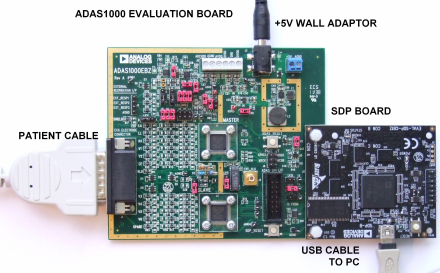
The EVAL-ADAS1000SDZ is a fully featured evaluation kit for the ADAS1000. The evaluation kit consists of an evaluation board kitted with 2 ADAS1000 devices capable of demonstrating ECG capture up to 12 leads. Included in the kit is a medical grade +5V wall adaptor with interchangeable worldwide wall plugs and a CD with user software for data capture and display. The software allows control of all ADAS1000 registers, ability to capture and display ECG data, respiration data, pace pulse detection and store data for offline processing. This evaluation board is provided for silicon evaluation purposes and is not designed to be connected directly to animal or human. This board operates in conjunction with the System Development Platform (SDP) or alternatively may be interfaced to directly via a dedicated serial interface connector (J4). The SDP controller board connects to the PC via USB 2.0. The evaluation board connects to the SDP controller board. The ADAS1000 evaluation board cannot be connected directly to the PC. The evaluation software running on the PC will communicate with the evaluation board through the SDP Controller board. The SDP Controller board is a separate list item in the ordering guide below (EVAL-SDP-CB1Z). If you have not previously purchased an SDP Controller board, please do so to ensure a full evaluation setup.
Applicable Parts
ADAS1000
Low-Power, 5-Electrode Electrocardiogram (ECG) Analog Front End with respiration measurement and pace detection)
ADAS1000-1
Low Power 5 electrode ECG Analog Front End
ADAS1000-2
Low Power 5 electrode ECG Analog Front End Companion Chip
ADAS1000-3
Low Power, 3-Electrode Electrocardiogram (ECG) Analog Front End
ADAS1000-4
Low Power, 3-Electrode Electrocardiogram (ECG) Analog Front End with respiration measurement and pace detection
Applications
Healthcare Solutions
- Activity Tracking and Fall Detection Solutions
- Respiration Rate Measurement Solutions
- Electrocardiogram (ECG) Measurement Solutions
- Wearable Health Monitor Solutions
- Therapy Device Solutions for Healthcare
- Oxygen Saturation (SpO2) Measurement Solutions
EVAL-ADPD6000

This user guide describes the operation of the EVAL-ADPD6000Z demonstration kit, which is an evaluation module for the ADPD6000.
The ADPD6000 is a fully integrated analog front end (AFE) for wearable vital signal monitoring (VSM) devices. The key functions of the ADPD6000 include photoplethysmography (PPG), electrocardiography (ECG), and body impedance analysis (BIA).
The demonstration kit includes both software and hardware. The EVAL-ADPD6000Z can evaluate the AFE feature and verify the system design based on the AFE. According to the requirements of the application, the user can use a cable connection or Bluetooth connection to establish communication between the PC and the EVAL-ADPD6000Z.
This user guide also describes the example configuration of the different functions of the ADPD6000.
For full details on the ADPD6000, see the ADPD6000 data sheet, which must be consulted in conjunction with the user guide when using the EVAL-ADPD6000Z.
Applicable Parts
ADPD6000
Multimodal Sensor Front End
Applications
Healthcare Solutions
- Body Composition, Hydration, and Bioimpedance Analysis Solutions
- Wearable Health Monitor Solutions
- Vital Signs Monitoring Solutions
- Electrocardiogram (ECG) Measurement Solutions
- Non-Invasive Blood Pressure (NIBP) Solutions
- Oxygen Saturation (SpO2) Measurement Solutions
- Respiration Rate Measurement Solutions
EVAL-AD5940ELCZ

The AD5940 is specifically designed for high precision analysis of electrochemical cells. This evaluation kit is designed to easily configure the AD5940 to perform electrochemical measurements on a typical electrochemical cell. The evaluation kit includes the EVAL-ADICUP3029 Arm® Cortex™-M3 microcontrollerbased Arduino Uno form factor board, the EVAL-AD5940ELCZ daughter board and custom micro USB to crocodile cables to connect the hardware to various chemistry setups.
Applicable Parts
AD5940
High-Precision, Impedance & Electrochemical Front End
Applications
Healthcare Solutions
- Continuous Glucose Monitor (CGM) Solutions
- Diabetes Monitoring and Diagnostic Solutions
- Therapy Device Solutions for Healthcare
- Point of Care (PoC) Diagnostic Solutions
- In Vitro Diagnostic Solutions
- Oxygen Saturation (SpO2) Measurement Solutions
- Electrocardiogram (ECG) Measurement Solutions
- Blood Glucose Meter Solutions
Intelligent Building Solutions
- Environmental Building Monitoring Solutions
- Building Automation Controllers and Network Solutions
Instrumentation and Measurement Solutions
- Impedance Measurement and Analysis Solutions
- Water and Air Quality Monitoring Solutions
- Science Lab Equipment Solutions
MAXM86161EVSYS

The MAXM86161EVSYS# evaluation system (EV sys-tem) allows for the quick evaluation of the MAXM86161 integrated optical module for applications at various sites on the body, particularly in-ear and mobile applications. The MAXM86161 device communicates using a standard I2C-compatible interface to Analog devices on-board MAX32664 Biometric Sensor Hub microcontroller (used for Analog devices algorithm evaluation) or in a pass- through mode for raw data collection. The MAXM86161 device consists of three optical readout channels that can be individually controlled (Green, Red, and IR). The EV system allows for flexible configurations to allow testing of various features of the sensor. Moreover, it helps the user quickly learn how to configure and use the MAXM86161 device.
The primary EV system consists of two circuit board assemblies (MAXSensorBLE_EVKIT and MAXM86161OSBFLEX), one USB-C to USB-A connector cable, and a Lithium Polymer battery. These components are highlighted in Figure 1 below. In addition, two programming circuit boards (MAXM86161_MAX32630_ PRGMR_ASSY, and the MAXREFDES100HDK) and one USB-B Micro-to-USB-A Male USB cable are provided for firmware updates if needed.
The EV system can be powered using a USB-C supply or LiPo Battery and comes with a MAXM86161EFD+ device in a 14-pin OLGA package.
The MAXM86161OSBFLEX Flex-Rigid circuit board has a Analog devices MAX32664 Biometric Sensor Hub microcontroller device installed. This Sensor Hub can be used to implement Analog devices HR/SpO2 Algorithm for evaluation. The MAXM86161 GUI PC application code that allows evaluation of both the MAXM86161EVSYS# and the MAX32664 Sensor Hub is available in the MAXM86161EVSYS# EV System Design Resources tab.
Applications
- Continuous Monitoring for HRV
- Miniature Package for Mobile Applications
- Optical Heart Rate
- Optimized for In-Ear Applications
- Optimized Performance to Detect:
- Oxygen Saturation (SpO2)
Applicable Parts
MAXM86161
Single-Supply Integrated Optical Module for HR and SpO2 Measurement
Applications
Consumer Technology Solutions
- Home Theater and Gaming Solutions
- Hearable and Wearable Solutions
Healthcare Solutions
- Non-Invasive Blood Pressure (NIBP) Solutions
- Oxygen Saturation (SpO2) Measurement Solutions
MAX86174EVSYS
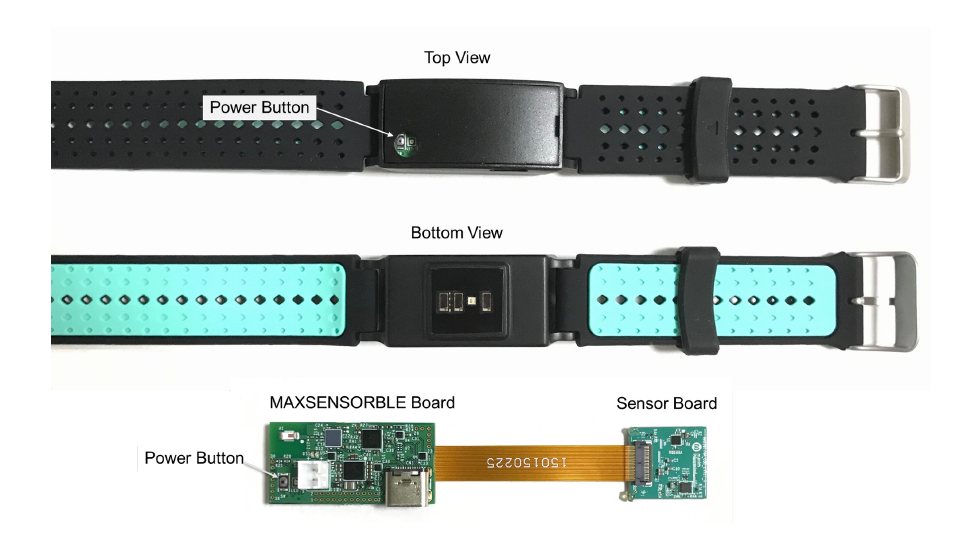
The MAX86174 evaluation system (EV Sys) provides a platform to evaluate the functionality and features of the MAX86174A with photoplethysmogram (PPG) measurement capabilities. The EV Sys allows for flexible hardware and software configurations to help the user quickly learn how to configure and optimize the MAX86174A for their own applications.
The MAX86174A is an ultra-low power PPG analog frontend solution that has dual optical-readout channels and supports up to 4 LEDs and 2 photodiode inputs. For more information, refer to the MAX86174A data sheet.
The MAX86174 EV Sys consists of two boards. MAXSENSORBLE_EVKIT_B is the microcontroller (MCU) board while MAX86174A_OSB_EVKIT_B is the sensor board containing the MAX86174A. To enable PPG measurement capabilities, the sensor board contains 3 LEDs (red, green, and IR in a single package: OSRAM SFH7016), three discrete photodiodes (Vishay VEMD8080), and an accelerometer. The EV Sys is powered through the included LiPo Battery. The EV Sys communicates with MAX86174GUI (should be installed in user’s system) using Bluetooth built into Windows (Win BLE). The EV Sys contains the latest firmware but comes with the programming circuit board MAXDAP-TYPE-C in case a firmware change is needed.
Applications
- Body Hydration
- Clinical Accuracy
- Heart-Rate Variability
- Maximum Oxygen Consumption (VO2 max)
- Muscle and Tissue Oxygen Saturation (SmO2 and StO2)
- Optical Heart Rate
- Optimized Performance to Detect
- Oxygen Saturation (SpO2)
- Suitable for Wrist, Finger, Ear, and Other Locations
- Wearable Devices for Fitness, Wellness and Medical Applications
Applicable Parts
MAX86174A
Best-in-Class Optical Pulse Oximeter and Heart-Rate Sensor AFE for Wearable Health
Applications
Consumer Technology Solutions
- Home Theater and Gaming Solutions
Healthcare Solutions
- Continuous Glucose Monitor (CGM) Solutions
- Diabetes Monitoring and Diagnostic Solutions
- Oxygen Saturation (SpO2) Measurement Solutions
MAX86177EVSYS

The MAX86177 evaluation system (EV system) allows for the quick evaluation of the MAX86177 optical AFE for applications at various sites on the body, particularly the wrist. The EV sys supports both I2C and SPI compatible interfaces. The EV sys has four optical readout channels that operate simultaneously. The EV sys allows flexible configurations to optimize measurement signal quality at minimal power consumption. The EV sys supports file logging and flash logging, allowing the user to disconnect from the computer for more convenient data capturing sessions, such as overnight or outdoor running.
The EV sys consists of two boards. MAXSENSORBLE_ EVKIT_B is the main data acquisition board while MAX86177_OSB_EVKIT_A is the sensor daughter board for the MAX86177. To enable PPG measurement capabilities, the sensor board contains six LEDs (two OSRAM SFH7016, red, green, and IR 3-in-1 LED package) and eight discrete photodiodes (OSRAM SFH2704), and an accelerometer. The EV sys is powered through a LiPo battery attached inside it and can be charged using a Type-C port. The EV Sys communicates with MAX86177GUI (should be installed in user’s system) using Bluetooth® built into Windows (Win BLE). The EV sys contains the latest firmware but comes with the programming circuit board MAXDAP-TYPE-C in case a firmware upgrade is needed.
Applications
- Optical Heart Rate
- Optimized performance for high SNR PPG signal to detect
- Oxygen Saturation (SpO2)
- Suitable for Wrist, Finger, Ear, Chest, and Abdomen
- Wearable Devices for Fitness, Wellness & Medical Applications
Applicable Parts
MAX86177
Quad-Channel AFE for Low-Power Heart Rate Monitor and Pulse Oximeter
Applications
Consumer Technology Solutions
- Hearable and Wearable Solutions
Healthcare Solutions
- Activity Tracking and Fall Detection Solutions
- Respiration Rate Measurement Solutions
- Electrocardiogram (ECG) Measurement Solutions
- Wearable Health Monitor Solutions
- Non-Invasive Blood Pressure (NIBP) Solutions
- Oxygen Saturation (SpO2) Measurement Solutions
- Body Temperature Measurement Solutions
Reference Designs
MAXREFDES105

Applicable Parts
Applications
Healthcare Solutions
- Activity Tracking and Fall Detection Solutions
Consumer Technology Solutions
- Hearable and Wearable Solutions
MAXREFDES104
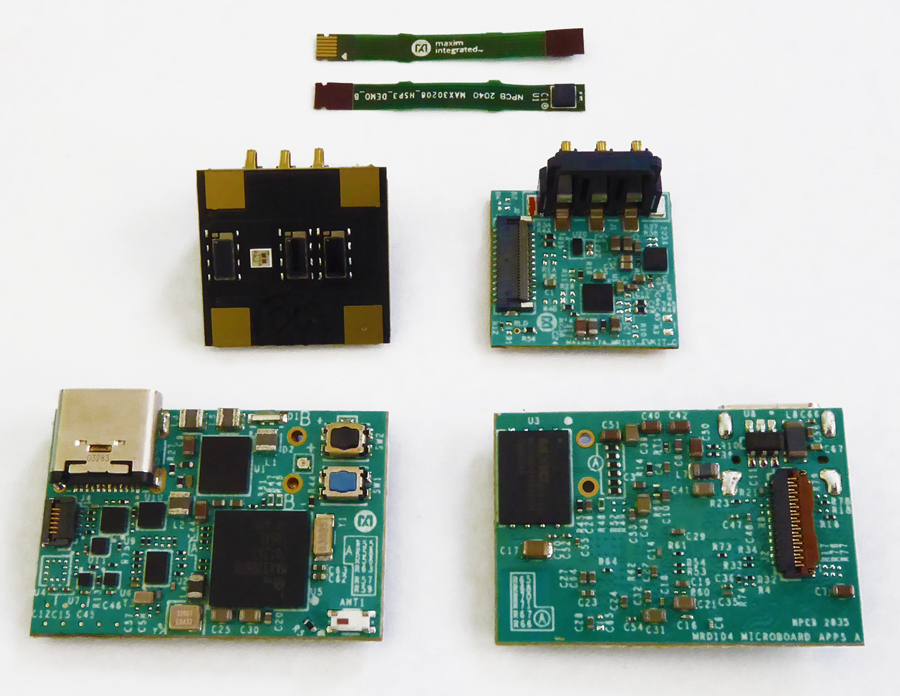
The MAXREFDES104# is a unique evaluation and development platform in a wearable form factor that demonstrates the functions of a wide range of Maxim’s products for health-sensing applications. This third-generation health sensor platform (an advancement of the MAXREFDES101# Health Sensor Platform 2.0) integrates a two-in-one PPG + ECG analog-front-end (AFE) sensor (MAX86176), a human body temperature sensor (MAX30208), a microcontroller (MAX32666), a power-management IC (MAX20360), and a 3-axis accelerometer. The complete platform includes a 3D-printed enclosure and a biometric algorithm hub with an embedded heart-rate, oxygen saturation and ECG algorithms (MAX32674). Algorithm output and raw data can be streamed through Bluetooth™ to a PC GUI for demonstration, evaluation, and customized development.
Applicable Parts
MAX86176
Ultra-Low-Power, Optical PPG and Single-Lead ECG AFE
MAX30208
±0.1°C Accurate, I2C Digital Temperature Sensor
MAX32666
Low-Power ARM Cortex-M4 with FPU-Based Microcontroller with Bluetooth 5 for Wearables
MAX20360
PMIC with Ultra-Low IQ Regulators, Charger, Fuel Gauge, and Haptic Driver for Small Li+ System
Applications
Healthcare Solutions
MAXREFDES282

This reference design provides information about preparing and operating the MAXREFDES282: Health Patch Platform. This platform uses high-sensitivity Photoplethysmogram (PPG), Electrocardiogram (ECG), Bio Impedance (BioZ) and temperature biosensors, and two power-management IC (PMIC) from Maxim Integrated®, now part of Analog Devices®, in a chest-patch design to capture biometric signals important for healthcare. The platform integrates algorithms to calculate those vital signs including heart rate (HR), respiration rate (RR), and blood oxygenation (SpO2) based on the biosensors measurement data. The vital signs data can be displayed on a Windows® GUI in real-time and logged to a local file for further study. This is a demonstration only reference design. The schematic, layout, and manufacturing files are not available.
Wearable and supporting documentation are available under NDA only.*
Applicable Parts
Applications
Healthcare Solutions
- Electrocardiogram (ECG) Measurement Solutions
- Body Temperature Measurement Solutions
- Oxygen Saturation (SpO2) Measurement Solutions
- Wearable Health Monitor Solutions
- Respiration Rate Measurement Solutions
MAXREFDES220

The MAXREFDES220# reference design provides everything you need to quickly prototype your product to measure finger-based heart rate, blood oxygen saturation level (SpO2), and blood pressure trending (BPT).
The MAX30101 and the MAX32664 provide an integrated hardware and software solution for multiple finger-based applications. The MAX32664 firmware provides algorithm output.
A MAX32630FTHR is provided to emulate a host system for easy development.
Design files, firmware, and software are available for this reference design. The board is also available for purchase.
Applicable Parts
Applications
Healthcare Solutions
- Oxygen Saturation (SpO2) Measurement Solutions
- Non-Invasive Blood Pressure (NIBP) Solutions
- Respiration Rate Measurement Solutions
